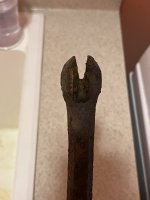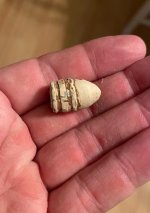Michigan Badger
Gold Member
I've been at this hobby now for 40+ years and hope to do it at least another 10.
Lately I've been thinking about depth and my old records from the 60's. Back then I was using a TR machine (Whites CoinMaster IV).
One day I dug a V nickel (still have it) at 4 1/2 inches. Another day I dug a 1936 silver quarter at 5+ inches. In 1983 using a Wilson Newman GBDII I dug 5 Indian pennies in one small area that were 7-9 inches deep. The area was fill dirt around a park restroom. I was using all-metal mode when I made the finds.
My average Indian head penny during the 1980's was just under 4 inches deep and gave a good signal while using my Fisher 1260-X.
Anyway, my point is, these depths are almost exactly the depths I'm seeing today. I'm digging the same types of coins at the same depths and getting about the same loudness of signal.
All of this makes me wonder just how far we have come since the 1960's.
I've read stories on this forum about digging coins at almost unbelievable depths. I have done this myself on occasion. I recall back in 1982 I dug a small silver watch fob that was so deep I was up to my elbow into the hole before I finally brought it up. I was using a Tecknetics (sp) 8500 in all-metal mode as I recall.
Are today's detectors really deeper or is it that sometimes soil conditions are just right and we dig that unusual mega deep find?
I know this thread probably won't last long but I'm just curious what some of you really think about all the hype today over depth.
Badger
Lately I've been thinking about depth and my old records from the 60's. Back then I was using a TR machine (Whites CoinMaster IV).
One day I dug a V nickel (still have it) at 4 1/2 inches. Another day I dug a 1936 silver quarter at 5+ inches. In 1983 using a Wilson Newman GBDII I dug 5 Indian pennies in one small area that were 7-9 inches deep. The area was fill dirt around a park restroom. I was using all-metal mode when I made the finds.
My average Indian head penny during the 1980's was just under 4 inches deep and gave a good signal while using my Fisher 1260-X.
Anyway, my point is, these depths are almost exactly the depths I'm seeing today. I'm digging the same types of coins at the same depths and getting about the same loudness of signal.
All of this makes me wonder just how far we have come since the 1960's.
I've read stories on this forum about digging coins at almost unbelievable depths. I have done this myself on occasion. I recall back in 1982 I dug a small silver watch fob that was so deep I was up to my elbow into the hole before I finally brought it up. I was using a Tecknetics (sp) 8500 in all-metal mode as I recall.
Are today's detectors really deeper or is it that sometimes soil conditions are just right and we dig that unusual mega deep find?
I know this thread probably won't last long but I'm just curious what some of you really think about all the hype today over depth.
Badger
Upvote
0






 and yes there is stuff even deeper especially round the old roman site and such,, then you would trench some of the top of and detect and find more deeper stuff,,,,,
and yes there is stuff even deeper especially round the old roman site and such,, then you would trench some of the top of and detect and find more deeper stuff,,,,, 


